#ruth plumly thompson
Text
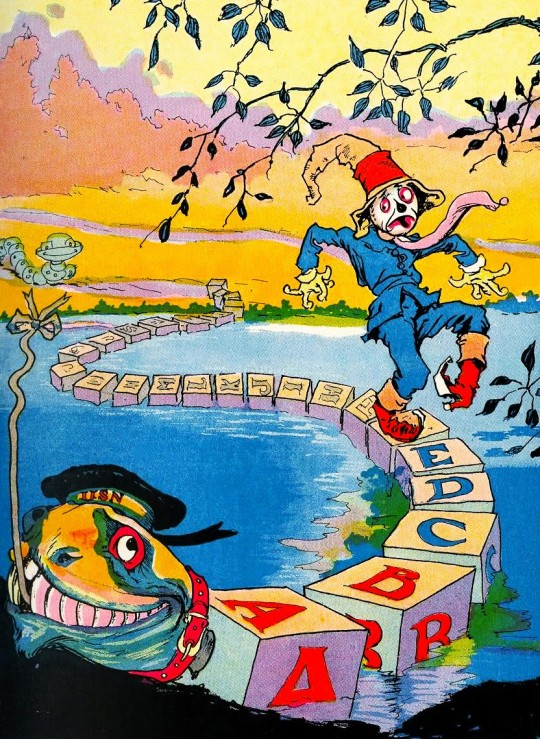
The Scarecrow and the A-B-Sea Serpent - The Royal Book of Oz, art by John R. Neill (1921)
#john r. neill#the royal book of oz#the wonderful wizard of oz#a-b-sea serpent#l. frank baum#ruth plumly thompson#the scarecrow#children's books#book illustrations#fantasy art#1920s#1921
499 notes
·
View notes
Text
We all know that Baum really enjoyed writing couples, particularly Dorothy/Ozma and Scarecrow/Tin Woodman. The first fourteen Oz books are chock-full of paragraphs detailing how close these characters are, with John R Neill providing some truly iconic illustrations for them!

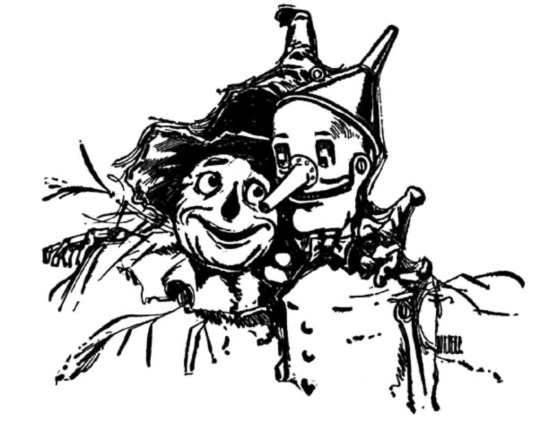
But all of that changed when Ruth Plumly Thompson took over for the series. For whatever reason she wasn’t nearly as fond of these couples as Baum was and it showed in her writing. The Tin Woodman was all but written out of her version of Oz, with the Scarecrow’s companion of choice now being the Patchwork Girl. Ozma got to stick around however, but her relationship with Dorothy was never as affectionate as before; they never kissed again in Thompson’s books.
But while Thompson may have wanted to break up Oz’s biggest power couples, it seems that John R Neill didn’t get the memo, bc he just kept on drawing them being hella affectionate!

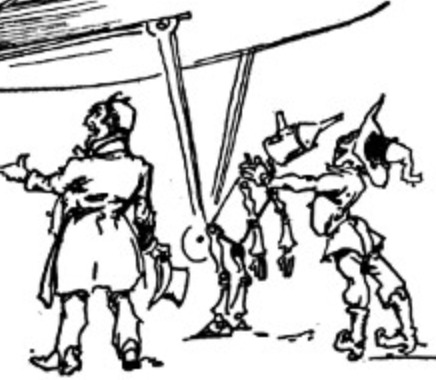

Gay rights. ✨
#the wizard of oz#dorothy gale#the scarecrow#the tin man#princess ozma#dorzma#tincrow#ozoplaning with the wizard of oz#ruth plumly thompson#l frank baum#every day's a good day to roast rpt
285 notes
·
View notes
Text
With all this talk of Mickey Mouse entering the public domain, we've all sadly overlooked an important addition to the public domain:
High Boy.
Not just any horse, THE Giant Horse of Oz, world-renowned!
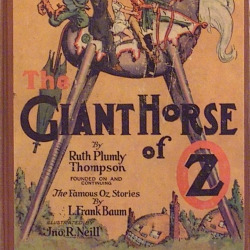
10 notes
·
View notes
Text
As much (mostly deserved) hate we give Ruth Plumly Thompson, you gotta admit that the "Ozites choose when they age" thing was a fantastic idea.
#ruth plumly thompson#land of oz#the wizard of oz#not sure what baum was thinking when he decided that no one in oz ever ages ever
15 notes
·
View notes
Text

excerpt from "The Ozmapolitan" (Issue 5, Reilly & Lee, 1928) featuring Ozma's thoughts on becoming a girl
#princess ozma#ozma of oz#tippetarius#oz books#shes like the most trans coded character possible from something published in the early 1900s#i adore her so much#“the remainder of my life- which is forever” also made me laugh#this was written by ruth plumly thompson rather than baum so im impressed w/ how good the whole issue is#you can find the full issue (and tons of other really great vintage oz stuff) on hungrytigerpress#ozposting
467 notes
·
View notes
Text

I'm fairly certain that ghosts aren't canon to Baum's Oz and that they don't show up in the books till Ruth Plumly Thompson wrote her sequels after his death. (I don't consider her books canon for many reasons which I won't get into today.)
If you like my comics, please consider supporting me: patreon.com/daisyfm
85 notes
·
View notes
Note
One thing I find really interesting about the wizard of oz illustrated books is that Dorthy looks like a full grown woman/older teen in a lot of the illustrations, yet the text continues to refer to her as a younger girl and gives a lot of indications that Dorothy's around 13 or so.
Yes, Neill's illustrations do give a sense of Dorothy "growing up" in Oz, even though the text introduces the concept of characters never aging. One illustration that has always stood out to me when I consider the idea of "an older Dorothy" is the art at the opening of The Magic of Oz of Dorothy and the Wizard:

There's actually a rather uncomfortable story about why Neill specifically started drawing Ozma as an adult on the covers of later editions of Ozma of Oz and Emerald City:

See, Ruth Plumly Thompson wrote the book Jack Pumpkinhead of Oz in 1929, and Ruth being Ruth, decided to introduce a really creepy and racist plot point about this Ethnic Stereotype Antagonist capturing the Emerald City and trying to marry Ozma, which leads to the worst thing I have ever seen:

Now, John R. Neill was evidently (like me) very uncomfortable with this and was like, "What the hell, Ruth? Um... how... how old is Ozma supposed to be here?"
To make it worse, Thompson describes Ozma as "a little girl fairy" in that book so... we've got a racialized antagonist trying to take a child bride thanks I hate it.
And so people have speculated that covers like the Ozma cover above were specifically made by Neill to try and mitigate the disturbing ramifications of that book.
(On another note, I NEVER want to hear someone call Dorzma "inappropriate" again when a concept as creepy as that Jack Pumpkinhead of Oz plot point is a part of an actual book in the friggin' Famous Forty. Two girls potentially having a crush on each other/falling in love after years is not inappropriate. Queer kids exist. That "Ozma marriage plot," however, is.)
45 notes
·
View notes
Text

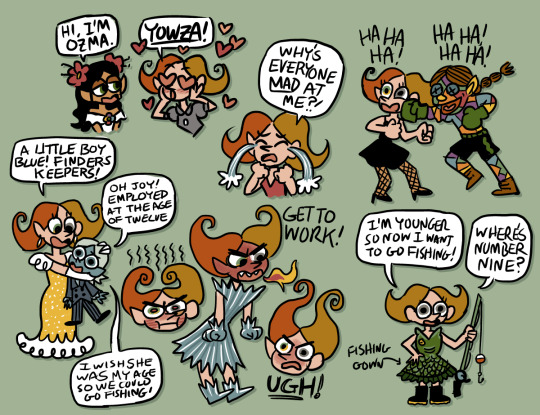
Jenny Jump
As part of an effort to provide sharable content while I'm (still!) refining my Oz comic script, here's some fan art of my favorite non-Baum Oz character: Jenny Jump. (still under copyright till 2036)
A lot of Oz fans don't "get" her, but Jenny Jump is a wonderful anti-hero protagonist: a fashionable half-fairy (split right down the middle) teenager from New Jersey. All of her emotions are constantly dialed up to eleven. She's so FUN!
Jenny's introduced in John R. Neill's Wonder City of Oz, where Oz is a bizarre rubber hose cartoon with living houses and cartoon physics. And the familiar characters all have cartoon personalities to match.
God, this book is ALMOST perfect.
The only real problem with this book was apparently added by an anonymous editor without Neill's input [spoiler for 83 year old book]: At the end, the Wizard "fixes" Jenny's personality by removing her anger, envy, and ambition.
But you know, I don't consider the magical lobotomy canon since Jenny Jump is absolutely perfect in every way and doesn't need fixing.
It's actually pretty great that I can just pick and choose what I accept as canon. One offensive illustration in an otherwise okay book from 1940? Not canon. Jenny Jump getting nonconsensually youthenized? Not canon. All of Ruth Plumly Thompson's books? Not canon.
Cross-posted from my Patreon. (link in bio)
#jenny jump#number nine#oz#wonder city of oz#oz books#fan art#scraps getting into scraps#oh look! ozma is in there too!#I'm always posting ozzy stuff these days...#a lot of people will tell you wonder city of oz has “bad writing” but I think it's delightful
80 notes
·
View notes
Photo

From The Cowardly Lion of Oz by Ruth Plumly Thompson and illustrated by John R. Neill, 1923.
Grab a hanky: here's my collection of vintage crying animals.
Wondering about this post? Wait for the dissertation (TBA).
For now: Weblog ◆ Books ◆ Videos ◆ Music ◆ Etsy
15 notes
·
View notes
Photo
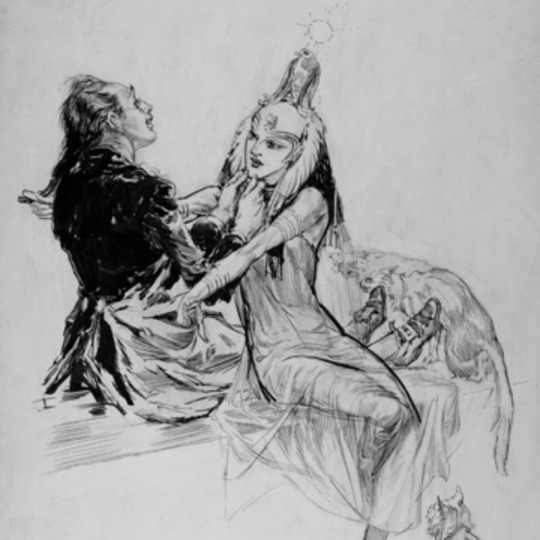


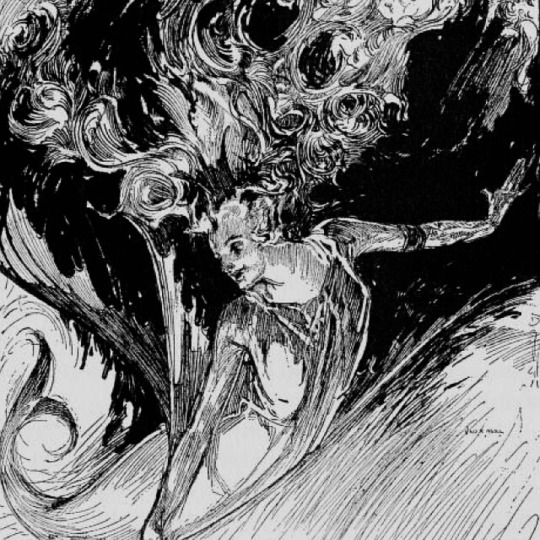


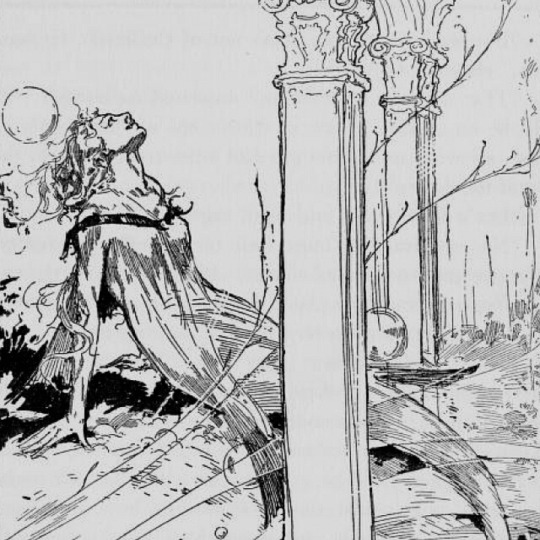
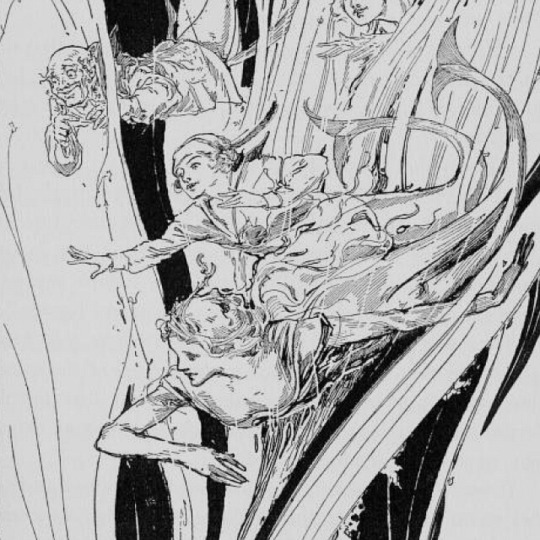

john r. neil (1877-1943) was a magazine and children's book illustrator primarily known for illustrating more than forty stories set in the land of oz, including l. frank baum's, ruth plumly thompson's, and three of his own
#i love love his work so i had to put something together for him#history#john r. neil#wizard of oz#art#vintage art#art history#myedit#*#mb#aesthetic
150 notes
·
View notes
Text
ok now i know why you all hate ruth plumly thompson
31 notes
·
View notes
Text
Ruth Plumly Thompson’s tenure as Royal Historian is quite fascinating imo because so many of her stories are prime with angst material, even though the writing itself is usually lackluster. Case in point, The Wishing Horse of Oz-
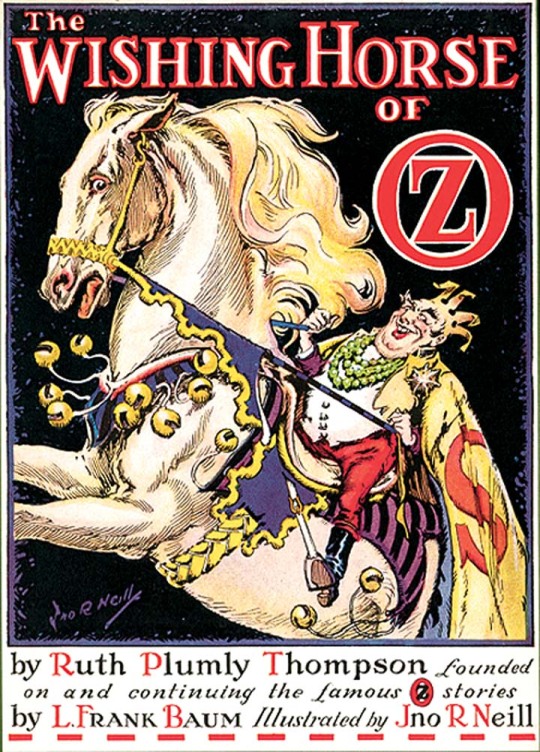
The basic plot is that this guy- King Skamperoo- gets these magic emeralds that grant wishes. So he uses their power to make himself the Emperor of Oz. This wish completely deposes all the rulers of Oz, so Ozma, Glinda, the Tin Woodman, and The Wizard all disappear and everyone in Oz forgets about them.

The only person who remembers them is Dorothy, who has to try and find them on her own. Since this is an RPT book the emotional weight of all this is completely glossed over, but the story is practically a goldmine for shipping angst!
As stated above, Dorothy is the only person who remembers Ozma. She’s essentially on a one-woman mission to rescue her girlfriend whom everyone tells her doesn’t exist. To say nothing about how the Scarecrow was forced to forget about the love of his life!
This story is absolutely ripe for Dorzma and Tincrow shipping fuel and I wanna see more people using it!
#the wizard of oz#dorothy gale#the scarecrow#the tin man#princess ozma#dorzma#tincrow#the wishing horse of oz#ruth plumly thompson
67 notes
·
View notes
Text
A fan curated this really lovely TV Tropes page for us. What an honor!
If you're a big Oz fan it's worth combing through to pick up on all of the little fun details. Who knows? Maybe add one or two of your own. Here's one of our favorites:
Mythology Gag:
Much like in The Chronicles Of Oz, the phrase "What did the Woggle-Bug say?" appears here, as a reference to the newspaper serial Queer Visitors from the Marvelous Land of Oz.
The Sawhorse lists off various ways to pronounce the word "Kalidah," telling Jessi and Wallace that different people pronounce it differently. Various adaptations of the Oz series have indeed disagreed on how the word should be pronounced.
Sissy can't remember the name of the Good Witch of the North, calling her "Locasty-poo." This of course references that the Good Witch of the North didn't have a name in the original book, but later books, stories and adaptations have switched between naming her "Locasta" and "Tattypoo" — the former was the name L. Frank Baum gave her in the stage play adaptation, and the latter was the name she was given in the book The Lost Princess of Oz by Ruth Plumly Thompson.
8 notes
·
View notes
Text
I love how when writing Ozoplaning with the Wizard of Oz, it’s obvious Ruth Plumly Thompson had no idea which characters were actually gonna be relevant in the MGM movie, so reading it is like, “ah yes, my favourite character from The Wizard of Oz... the Soldier with the Green Whiskers.”
14 notes
·
View notes
Text
Oz: What are the Famous Forty?
What are the « Famous Forty »?
Well, you must know by now that L. Frank Baum ended up writing fourteen Oz book, forming a series starting in 1900 and ending in 1920. The thing is, Reilly &Lee, the publishing house of Baum, knew very well how successful and popular the Oz series was, and refused to let it die with its creator. They hired new authors that became “Royal Oz Historians” and they were allowed to continue the Oz series – resulting in a total of forty “official” and “canon” book forming the full Oz series, as published by Reilly & Lee.
After Baum’s death, the publishing house put the Oz series in the care of Ruth Plumly Thompson. She ushered the second Oz era, by writing 19 Oz books, starting in 1921 and ending in 1939. Ruth Thompson style is quite different from the one of Baum: most notably, she tried to turn the Oz world into a more “classic fairytale” universe, by going a bit away from Baum’s innovations and novelties (for example, she turned the “Nomes” into “Gnomes”). Baum never had any male hero – Ruth had almost only male heroes. She was the one who introduced the most of the male protagonists of Oz, and she also had a greater focus on romance, weddings and royalty than Baum, a lot of her protagonists being princes and ending up married by the end of her novels. As a result, her books are quite controversial – for example, not everyone agrees with her decision to consider the Good Witch of the North’s old age a “curse” brought to her by enemies, that needs to be lifted so she can leave her job as the benevolent magic ruler of a region to become the pretty princess married to the kind of a city. But her presence in the Oz landscape stays very strong.
While she stopped participating in the Famous Forty in the 30s, she ended up releasing two more Oz books in the 70s: “Yankee in Oz” in 1972, and “The Enchanted Island of Oz” in 1976.
By this point, there were 33 Oz books.
The next official Oz historian was John R. Neill. He actually had participated in the Famous Forty before – he was the official Oz illustrator. He started illustrating the books with Baum’s “The Marvelous Land of Oz”, taking over from W. W. Denslow, and he ended up illustrating all of Baum’s and Thompson’s books. John Neill wrote three books for the Famous Forty, between 1940 and 1942: “The Wonder City of Oz”, “The Scalawagons of Oz” and “Lucky Bucky in Oz”. He actually had written a fourth Oz book for the Forty, but while he wrote it before his death he did not had time to illustrate it. The manuscript was however kept by his widow, and while not part of the Famous Forty, it was published in 1995, illustrated by Eric Shanower: “The Runaway in Oz”.
Neill’s take on Oz has been described as more… “manic”. Basically he had a children book illustrator’s mind when dealing with Oz, resulting in strong exaggerations – such as each quadrant of Oz being entirely of their associated color (from the sky to the skin color of people), or literally everything being alive in Oz, including houses.
After John Neill’s death, the next Oz Historian was Jack Snow. He was an avid fan of Baum’s writing as a child – in fact, when Baum died, Jack Snow offered to become the next Historian of Oz. It did not work, because he was only twelve years old at the time, but he ended up becoming the fourth Historian. He wrote two books for the Famous Forty: “The Magical Mimics of Oz” in 1946, and “The Shaggy Man of Oz” in 1949. It was rumored he had planned a third book, “Over the Rainbow to Oz”, but no manuscript was ever found. Snow wanted to return to a sort of Baum “fundamentalism”, by ignoring all the books of the previous Oz Historians and continuing right after Baum’s original books. Outside of his Oz writings, Snow was also a writer of ghost and horror stories for “Weird Tales”, and he notably produced a very daring short story – “A Murder in Oz”, trying to tie his two passions together by exploring the issue of the separate entities of Tip and Ozma. You must guess that the Oz editors refused to have such a story published, but it was eventually released by The Baum Bugle (the journal of the International Wizard of Oz Club, that started in 1957 and is still being published). Jack Snow also wrote “Who’s Who in Oz” in 1954, an extensive guide to all the characters in the Oz books. While the book was praised at the time and is still an important source of information, by now many have pointed several irregularities due to Jack Snow visibly misreading some of the characters (or simply losing track after reading 39 books in a row).
So, we are at a total of 38 books now. Only two were missing to form the Famous Forty.
The 39th book was written by Rachel R. Cosgrove: “The Hidden Valley of Oz”, released in 1951. She had written a second Oz book in 1954, “The Wicked Witch of Oz”, which tackled the issue of the missing Wicked Witch of the South, but she could not publish it, since Reilly & Lee considered the Oz books were not selling well anymore and wanted to close the series. The novel ended up however released by the International Wizard of Oz Club in 1993, illustrated by Eric Shanower. Rachel Cosgrove was notable for dismissing any kind of adult fan of Oz – she explained in the documentary “Oz: The American Fairyland” that she considered Oz to be a series for kids, that should not be enjoyed by adults.
The last book of the Famous Forty was “Merry Go Round in Oz”, released in 1963, and written by a collaboration: Eloise Jarvis McGraw and Lauren Lynn McGraw (mother and daughter). The two published another Oz book in 1980 (The Forbidden Fountain of Oz), while Eloise published on her own “The Rundelstone of Oz” in 2000.
There. These are the Famous Forty Oz book, the “complete official series”.
After that, the International Wizard of Oz Club published several books: as I mentioned they published the books of Ruth Thompson that were not included in the Famous Forty, as well as “The Forbidden Fountain” of the McGraw duo and “The Wicked Witch of Oz” of Rachel Cosgrove.
To these already mentioned book you can add “The Ozmapolitan of Oz”, a 1986 book by Dick Martin ; and two books by Gina Wickwar, “The Hidden Prince of Oz” in 2000 and “Toto of Oz” in 2006.
Finally, The L. Frank Baum Family Trust authorized an author named Sherwood Smith to publish new Oz books, declaring them officially canon. With this authorization, Smith wrote a trilogy between 2005 and 2014: “The Emerald Wand of Oz”, “Trouble Under Oz” and “Sky Pyrates Over Oz”.
These are all the books that could be considered “canon”.
Of course there’s always one more; the “orthodox sequels”. Books that try their best to be sequels or continuations of the official Oz books and their canon, but were not officially recognized as canon. There are several of them, starting in 1985 with James Howe’s “Mr. Tinker in Oz” and ending with “A Nightmare in Oz”, published in 2020 by David M. Keyes. A lot of them were made by members of Baum’s family, though there is a debate as to whether they should be considered “orthodox sequels” or rather “alternate Oz” books, but that’s for another time.
3 notes
·
View notes
Text
Posted a review of Oz Continued #20: The Hungry Tiger of Oz by Ruth Plumly Thompson on my blog. Read it here.
tl;dr – Still not my thing
0 notes